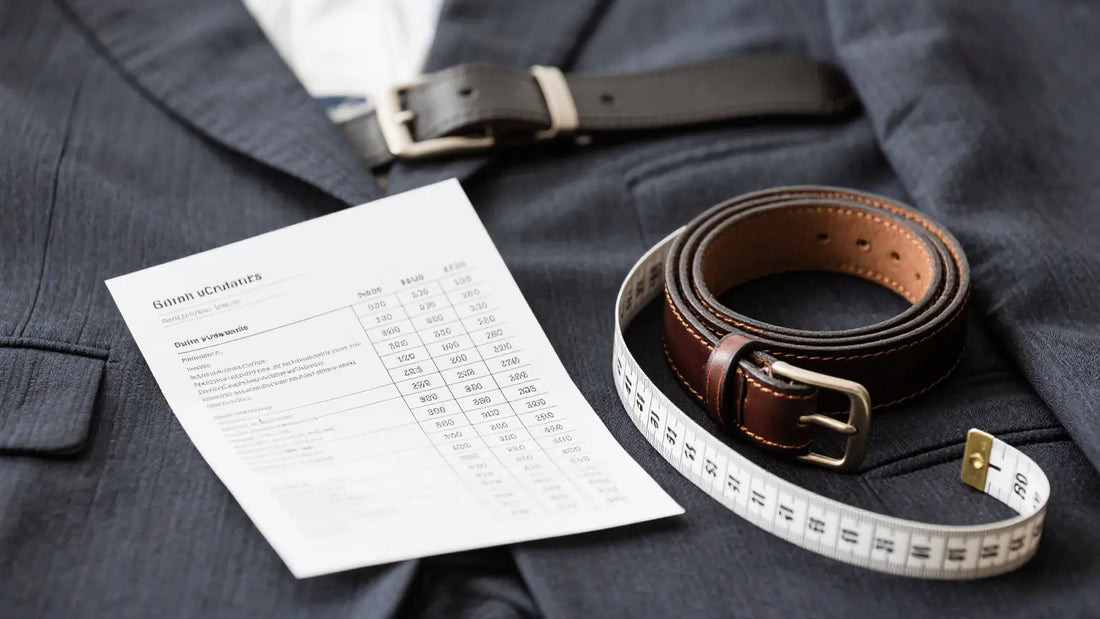
8 Proven Belt Size Chart Rules to Avoid Wrong Purchases
Share
Introduction
Few things are more frustrating than buying a belt that doesn’t fit. Too loose, too tight, or hanging awkwardly — it ruins not only your outfit but also your confidence. The good news? A proper belt size chart eliminates the guesswork.
Most men don’t realize that belt sizing isn’t identical to pant sizing, and that small mistakes often lead to wasted money and ill-fitting accessories. In this article, we’ll walk through 8 proven belt size chart rules to help you find the perfect fit every time, avoid costly mistakes, and shop with confidence.
Table of Contents
Rule #1 – Always Measure Your Waist Correctly
Rule #2 – Understand the Belt Size vs. Pant Size Difference
Rule #3 – Follow the Standard 2-Inch Rule
Rule #4 – Use a Belt Size Chart for International Conversions
Rule #5 – Choose the Right Belt Hole Position
Rule #6 – Consider Belt Width Along with Size
Rule #7 – Adjust for Different Styles (Formal vs. Casual)
Rule #8 – Double-Check Before Online Purchases
Bonus Tips for Perfect Belt Fitting
FAQs About Belt Size Charts
Conclusion
Rule #1 – Always Measure Your Waist Correctly
The foundation of a proper fit starts with an accurate waist measurement. Use a soft tape measure and wrap it around your waistline, where you usually wear your trousers.
Don’t pull the tape too tight.
Measure while standing in a relaxed position.
Write down the measurement in both inches and centimeters.
Browse our Dress Belts collection to see which belts are suitable for your size.
Rule #2 – Understand the Belt Size vs. Pant Size Difference
A common mistake is assuming that belt size equals pant size. In reality, belt size is usually 2 inches larger than your pant size.
If your pants are size 34, your belt size will likely be 36.
Belt charts exist to highlight this difference and prevent buying too small.
Rule #3 – Follow the Standard 2-Inch Rule
Most belt size charts recommend adding 2 inches to your pant waist size. This ensures that the belt fits comfortably in the middle hole, giving you room to adjust either way.
Pant size 32 → Belt size 34
Pant size 36 → Belt size 38
This rule is simple but effective.
Rule #4 – Use a Belt Size Chart for International Conversions
If you’re shopping internationally, sizing can vary:
US vs. EU sizes may use different number systems.
Some charts use centimeters, while others use inches.
A reliable belt size chart with conversion tables will save you from major confusion.
External resource: Size Conversion Guide – ASOS
Rule #5 – Choose the Right Belt Hole Position
The ideal belt should fasten at the third hole (the middle one). This balances style and function while allowing flexibility for small weight fluctuations.
If you’re always on the first or last hole, it’s a clear sign that your belt size is wrong.
Rule #6 – Consider Belt Width Along with Size
Width matters as much as length:
Formal belts: Slimmer (1–1.25 inches) to match dress pants.
Casual belts: Wider (1.5–1.75 inches) for jeans and chinos.
Even with the correct belt size, the wrong width can cause fitting issues with pant loops.
Rule #7 – Adjust for Different Styles (Formal vs. Casual)
Not all belts are sized equally. For instance:
Designer or luxury belts may have unique sizing charts.
Casual belts with thicker leather often run tighter.
Always check the manufacturer’s belt size chart before buying.
Rule #8 – Double-Check Before Online Purchases
When shopping online, don’t rely solely on your memory or assumptions. Before clicking “Add to Cart”:
Re-measure your waist.
Re-check the size chart provided by the brand.
Confirm if the chart lists belt length (end-to-end) or waist size.
This final check avoids unnecessary returns.
Bonus Tips for Perfect Belt Fitting
Try different hole counts: Belts with 7 holes offer better flexibility than 5-hole belts.
Account for weight changes: If you fluctuate between sizes, size up slightly.
Invest in adjustable or ratchet belts: These offer micro-adjustments without worrying about exact hole placement.
FAQs About Belt Size Charts
Q1: Is belt size the same as waist size?
No. Belt size is generally 2 inches larger than your pant waist size.
Q2: Should I size up or down if I’m between sizes?
Always size up. A slightly longer belt is easier to adjust than one that’s too short.
Q3: How do I measure an existing belt for size?
Measure from the buckle’s start (not including the buckle) to the hole you use most often.
Q4: Do all brands follow the same belt size chart?
No. Some designer brands use unique sizing. Always check each brand’s guide.
Q5: Are belt size charts necessary for elastic or stretch belts?
They’re less critical but still useful, especially if you want precise fitting.
Conclusion + CTA
Buying the wrong belt size is one of the most common yet avoidable mistakes in men’s fashion. By following these 8 proven belt size chart rules, you’ll always enjoy a comfortable fit, elegant look, and smarter shopping decisions.
Looking for a belt that really fits you? Browse our Dress Belts now.
Upgrade your wardrobe with belts that fit right the first
